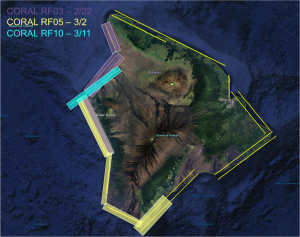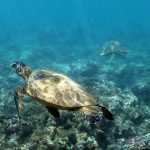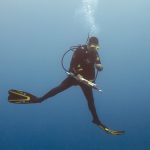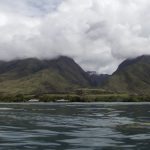The COral Reef Airborne Laboratory (CORAL) mission just wrapped up its second field campaign—this time in Hawaii—after spending more than a month working around challenging local weather conditions. Read a wrap-up of the campaign in this NASA Earth Expeditions blog.
During the months of February and March, CORAL conducted airborne (Feb 1-Mar 15) and in-water (Feb 13-24, Mar 4-11) surveys of the main Hawaiian islands, with the majority of validation effort taking place in Kaneohe Bay as shown in the map below.
All three field teams (benthic, metabolism and optics) were deployed in Kaneohe Bay. During this effort, a total of 8 metabolism sites, 47 optics sites, and 48 benthic sites were studied. Following the time in Kaneohe, the benthic team traveled to the outer Hawaiian islands to collect additional benthic validation points, as well as seafloor spectral reflectance, which will also be used for validation. In the outer Hawaiian islands, the benthic team visited 8 sites on Lanai, 21 sites on Maui, and 14 on the Big Island.
The airborne team, based at the Hawaii International Airport, Air Service Hawaii (FBO), worked in close coordination with field teams to conduct 10 successful days of flight operations in what was, often, challenging and adverse weather conditions. Unfortunately, weather (clouds) prevented vicarious match-up of PRISM with in-water optics, so optics data will be used to generally parameterize CORAL algorithms, rather than for strict validation. However, metabolism and benthic sites were solid match-ups and will be used for validation of PRISM data.
- CORAL flight lines on the Big Island
- CORAL flight lines on Kauai
- CORAL flight lines on Maui, Molokai, and Lanai
- CORAL flight lines on Oahu
Photo Gallery
- Yvonne Sawall, part of the benthic team, carries equipment to a site in Kaneohe Bay
- Scenic view of a reef flat in Kaneohe Bay (Oahu)
- Alex “Dready” Hunter and Steve Dollar, both part of the benthic team, head to a site in Kaneohe Bay
- Brandon Russell, part of the optics team, prepares instruments for deployment in Kaneohe Bay
- The benthic team is visited by resident turtles on Maui
- Benthic team member Steve Dollar heads to a survey site in Maui
- Stacy Peltier, part of the benthic team, holding survey bars during underwater work
- A scenic underwater view of Maui’s reefs
- A view of Maui’s mountains from the water
- Benthic team member Andrea Millan conducting a survey in Maui
- Eric and Ali Hochberg head back into dock on Coconut Island
- Eric Hochberg, Yvonne Sawall, and Bob Carpenter have an informal team meeting on Coconut Island prior to going out in the field
For continued updates on CORAL, including future campaigns to Guam and Palau, visit us on Facebook (@coralreefairbornelaboratory) and online at www.coral.bios.edu and www.coral.jpl.nasa.gov. The CORAL Flight Locator Tool can be used to track CORAL flights and access CORAL data.


















